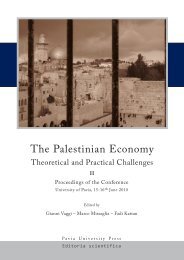Musica che affronta il silenzio - Scritti su Toru Takemitsu - Pavia ...
Musica che affronta il silenzio - Scritti su Toru Takemitsu - Pavia ...
Musica che affronta il silenzio - Scritti su Toru Takemitsu - Pavia ...
You also want an ePaper? Increase the reach of your titles
YUMPU automatically turns print PDFs into web optimized ePapers that Google loves.
122<br />
Luciana Galliano<br />
‘global intellectual’. Thus clearly there has been no single aesthetic and compositional<br />
project in more than forty years of activity, but rather he has his own history, in which I<br />
wish to pick out some moments which I believe are particularly salient:<br />
1. his début, in which the most important element was to rebel against any<br />
imposition. The only input he would act on was his own creativity and sensib<strong>il</strong>ity,<br />
and indeed he was even prepared to call the latter into question. His<br />
youth, and discussions with his friends in Jikkenkb, were enri<strong>che</strong>d among<br />
other things by Catholic humanism, which stimulated his dialogue with Yuasa<br />
and Fukushima, the latter composer in particular being close to an informed<br />
awareness of Zen ph<strong>il</strong>osophy. In this early phase Takemit<strong>su</strong>’s project was to<br />
give a sense to his soundscape: ‘I became aware that composing is giving<br />
meaning to that stream of sounds that penetrates the world we live in’<br />
(Takemit<strong>su</strong> 1995: 79). 9 This involved the highest degree of independent,<br />
original liberty. The fascination of a profound disquiet led Hidekazu Yoshida,<br />
the critic who in a certain sense had discovered him at the time of Lento, to<br />
say: ‘Takemit<strong>su</strong>’s music intoxicates us’;<br />
2. we can identify a second period, roughly speaking, in the explosion of his<br />
rebellious attitude, with the collective demonstrations against m<strong>il</strong>itary engagement<br />
and the ‘revolutionary’ activity that went on in the Sget<strong>su</strong> centre,<br />
and indeed his participation, with his lifelong friend Kuniharu Akiyama, in<br />
Fluxus. This gave rise to the expressive violence of a piece like Textures<br />
(1964). As Takemit<strong>su</strong> himself said in 1968: ‘The form of my music is the direct,<br />
natural outcome imposed by the sounds themselves, which is in no way<br />
predetermined from the outset’, or again: ‘I don’t want to aim to control the<br />
sounds. I prefer to leave them free, if possible without controlling them. I<br />
would be happy just to gather them around me and impart a minimum of<br />
movement’ (Takemit<strong>su</strong> 1971: 206). The composer is aware that his works<br />
‘liberated music from a certain stagnation and brought to music something<br />
distinctly new and different’. 10 Takemit<strong>su</strong> also became aware of the peculiarities<br />
and innovations – with respect to his formation – of some of the aesthetic<br />
is<strong>su</strong>es in Japanese art and music, without however wishing in any way to mediate<br />
between the two; this is the idea of the ‘non transportab<strong>il</strong>ity’ of Japanese<br />
concepts and materials, splendidly expressed in November Steps (1967);<br />
3. following his encounter with traditional Japanese musical aesthetics, a truly<br />
formidable heritage, we can recognise a change of direction; Takemit<strong>su</strong> says<br />
that previously ‘when I structured a piece I composed as if I was assembling<br />
9 Dating back to 1948.<br />
10 From a lecture given on 6 July 1988 at the “First New York International Festival of the Arts”.

















